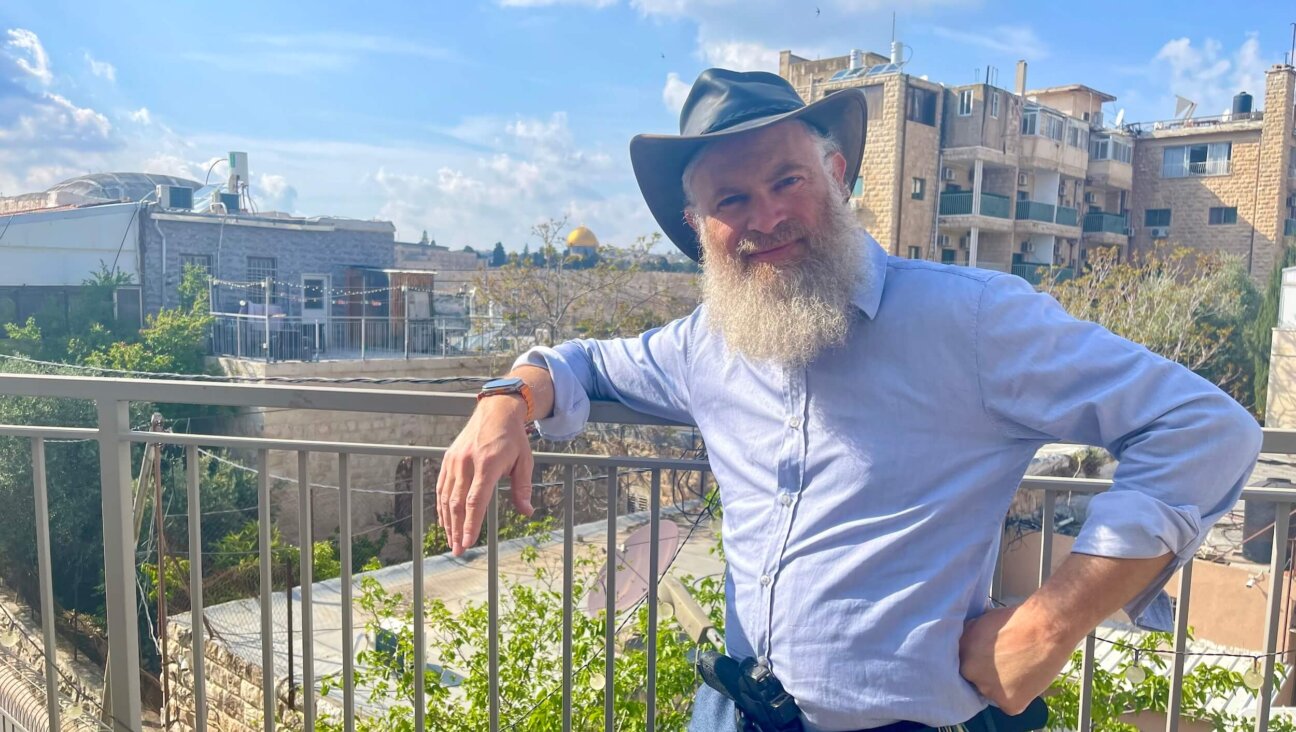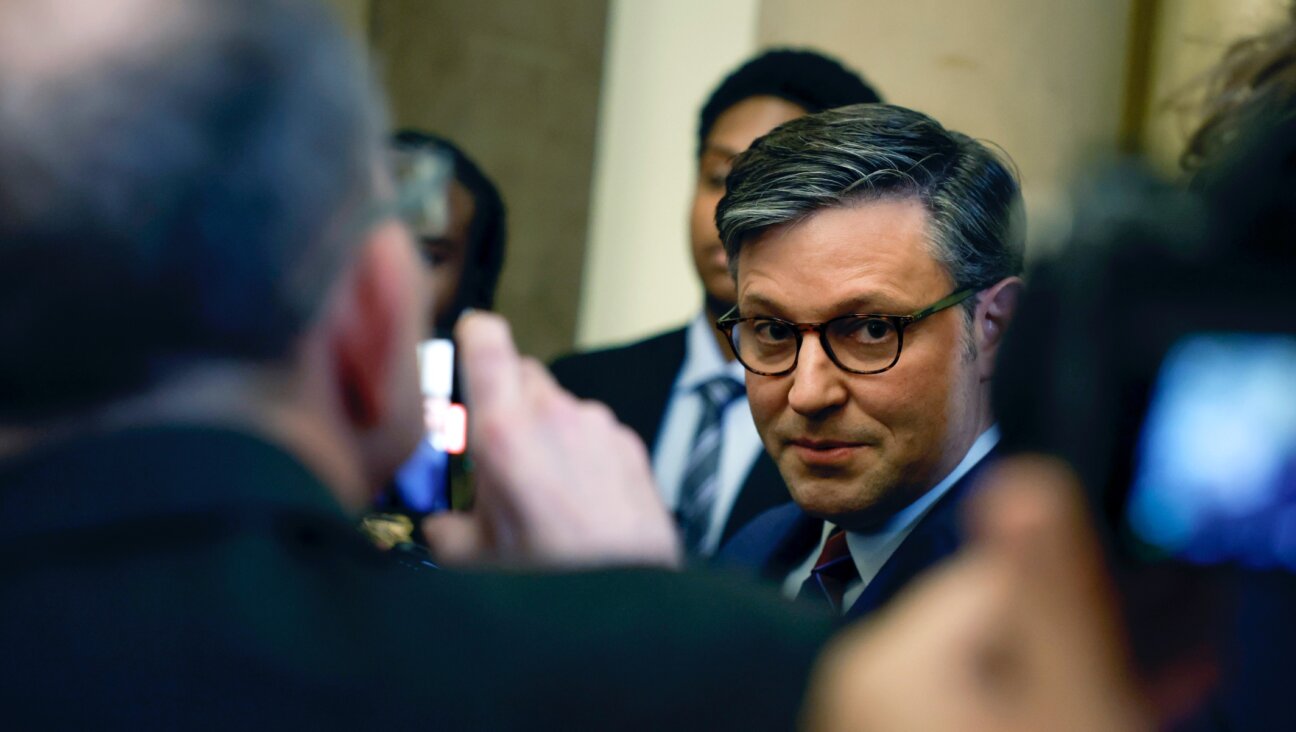Tovah Feldshuh Shines on Broadway

On Stage: Tovah Feldshuh stars in ?Irena?s Vow.? Image by KAREN LEON
HEAVENLY ACCOLADE AT BROADWAY OPENING OF FELDSHUH IN ‘IRENA’S VOW’

On Stage: Tovah Feldshuh stars in ?Irena?s Vow.? Image by KAREN LEON
Those present at the March 29 Broadway opening night of Dan Gordon’s “Irena’s Vow,” starring Tovah Feldshuh, will always remember the thunderclap that shook the Walter Kerr Theatre. During the post-performance question-and-answer session with Janina Opdyke Smith, daughter of Irena Gut Opdyke, whose heroism fuels the play and whom Feldshuh brilliantly channels, a woman in the audience asked how her mother (who helped save a dozen Jews by hiding them in the home of a Nazi officer) could maintain her belief in God. Before Smith could reply, there came a shattering ka-boom! Some gasped. Some laughed. Some Catholics may have crossed themselves. But it was Feldshuh’s instantaneous gaze toward heaven, with hands clasped as if in prayer, that helped imprint this Cecil B. DeMille-ish moment as singular in Broadway history. Witnesses to this phenomenon included Neil Simon, David Hyde Pierce, Elaine Stritch, Kathleen Turner, Blythe Danner, Joel Grey, Linda Gray, David Morse, Paul Libin, John Ruskay, Zygmund Rolat and Poland’s consul general in New York, Krzysztof Kasprzyk, who told me that a delegation of Polish rescuers will be coming to New York on April 15 to see the play.
Having lost 22 pounds since her appearance in the off-Broadway launch of “Irena’s Vow” in an attempt to more closely represent the young Opdyke, Feldshuh exudes stamina that is a tribute to theatrical discipline and to Jenny Craig, the company she credits with her newfound “svelteness.” Whatever minor reservations I have about some aspects of the supporting cast’s performances, all is forgiven in the spirit of Opdyke’s courage and heroism, which director Michael Parva manages to make accessible and inspiring. What also made the night special was the presence in the audience of the grandson of a Jewish couple Opdyke saved.
In an interview published in “Rescuers: Portraits of Moral Courage in the Holocaust” by Gay Block and Malka Drucker, with a prologue by Cynthia Ozick (TV Books, 1992), Irena Gut Opdyke, who was honored by Yad Vashem in Israel and given a special commendation by the Vatican, recalls: “In 1975 I heard a neo-Nazi say that the Holocaust was a hoax, and I decided I had to start talking. I think another Holocaust could happen if we don’t mingle together to try to understand one another and not be ignorant.… So for the last 10 years, I’ve been telling my experiences.… We all have to reach out to know we’re not alone in the world.” Irena Gut Opdyke, who died in May 2003, can no longer tell her story or promote her message. Feldshuh continues her imperative by giving voice to this extraordinary Righteous Gentile in “Irena’s Vow.” Do not miss!
CASTLE CONNOLLY PRESENTS NATIONAL PHYSICIAN OF THE YEAR AWARDS
Everyone has a mother, uncle, boss or friend who touts his doctor as “the best!” but to avoid family feuds and fractured friendships, a better bet may be Castle Connolly, Medical Ltd.’s “America’s Top Doctors” or “America’s Top Doctors for Cancer.” These reference books list top regional and national doctors who are picked by fellow physicians and specialists in their respective fields. Castle Connolly’s March 23 National Physician of the Year Awards Dinner honored Dr. Emil Freireich, who described his “Aha!” moment that led to children with leukemia having a future and life. Born in Hungary, Freireich, who is currently with the M.D. Anderson Cancer Center, began treating leukemia in 1955. “The life span for children was eight weeks to one year. The wards had newborns with the median age 5… they would hemorrhage, spraying blood onto the ceiling, bleeding from their eyes.… These children had no platelets!” His concept of transferring blood platelets from donors to children “gave these children life. In 10 years, we helped cure childhood leukemia.”
Dr. Diane Meier, professor of geriatrics and internal medicine and Catherine Gaisman professor of medical ethics at Mount Sinai School of Medicine in New York City, was honored for championing the concept of palliative care to improve the quality of life of those who are “chronically ill or have serious illnesses.” Meier is also director of the Center to Advance Palliative Care in the United States. During our post-ceremony chat, Meier (who told me, “I know the Forward!”) said: “The U.S. is way ahead of the rest of the world in palliative care [because] it is paid by Medicare… I saw that medicine did not address family suffering of untreated patients; there was a need to develop a process of quality care.” She cited a patient, a middle-aged man, who noticed a lump on the back of his tongue. His dentist identified it as cancer that needed aggressive surgery with the hope that he will be cured. Toxic chemotherapy and radiation led to anxiety, depression, panic, inability to work. “He needed psychiatric and psychological support — palliative care,” Meier said. “He is now working full time.”
“I am the son of working people in rural Middle Pennsylvania,” honoree Dr. Judd Moul told the assembled guests at New York’s Hudson Theater. At Duke University, Moul is a professor and chief of the Division of Urologic Surgery and director of Duke Prostate Center at Duke University Medical Center. He is also attending urologic oncologist at Walter Reed Army Medical Center in Washington, D.C., and spent 26 years as an American military physician. “I was the first in my family to go to college, following the death of my father in a mining accident… and am living the American Dream,” he added. In 2006, Moul was selected as chairman of the newly founded American Urological Association Foundation Education Council.
“Medicine is a calling, not a career,” declared honoree Dr. Carol Bradford, professor and chair of the Department of Otolaryngology-Head and Neck Surgery at the University of Michigan Medical School. “I knew in high school I wanted to pursue medicine… I practice in an area that deals with the ability to talk, speak, swallow.” Her primary research focus is “devoted to understanding the biology of treatment response in head and neck cancer and finding innovative strategies to overcome treatment resistance.”
Castle Connolly’s National Health Leadership Award was presented — in absentia — to Page Morton Black, who for 25 years was chairman of the Parkinson’s Disease Foundation. PDF was established in 1957 by her late husband, William Black, founder of Chock Full o’ Nuts., and Black, a singer and piano player, is famous for singing the iconic Chock Full o’ Nuts “heavenly coffee” jingle. Since its founding, PDF has funded more than $75 million for scientific research in Parkinson’s disease. Past honorees for this award include Princess Yasmin Aga Khan, president of Alzheimer’s Disease International, and Suzanne and Bob Wright, co-founders of Autism Speaks TM.
‘AMERICAN SWING’ NOT EVERYBODY’S CUP OF SMUT
After viewing Mathew Kaufman and Jon Hart’s documentary, “American Swing,” about Larry Levenson’s legendary swinging club, Plato’s Retreat, where any stranger’s bodily orifice is your anonymous new friends’ orifice, I felt I needed an anti-bacterial shower. This documentary chronicle of the 1970s-80s famous-infamous hot, hot, hot spot includes flashbacks and interviews with talking heads who recall their multi-person sexual partnering in “The Mattress Room,” aka “The Orgy Room,” with nostalgia. A blond grandmotherly woman, seen in a decades’ earlier film clip bracketed by an entourage of male partners of all ages and sizes, expresses a return to that time and place — to a time when there was no concern about sexually transmitted diseases, and when “AIDS” was a chocolate appetite suppressant-weight loss promotion candy and spelled with a Y instead of an I. (The company disappeared from drugstore shelves once the disease emerged.)
In one of the film’s many bizarre moments, Plato’s founder, booster and defender, Levenson, declares in a TV interview that the “chlorine in the air above the swimming pool kills AIDS!” And sex maven Helen Gurley Brown, former Cosmopolitan editor, declares the place to be “yummy!”
Described as “the poor man’s Playboy mansion” that attracted “judges, lawyers, police, students,” where “men met their wives” and which was visited by such celebrities as Jerzy Kosinski, Richard Dreyfus and Abbie Hoffman, Levenson compared Plato’s Retreats’ excesses to a party, a “bar mitzvah.” After all, the film identifies much of its clientele as likely synagogue-going Hebrew-school graduates who moved to Long Island and spent time attending a “family day” at the Concord hotel. Someone called Plato’s “a therapeutic” place. Touting the normalcy of the clientele, one patron in the film states: “We all have jobs. We all have mortgages.”
By the time Levenson is indicted for tax evasion and sent to prison, and Plato’s is padlocked for good, there is a feeling of pity and compassion for the man who, according to someone in the film, “never had a thought, never read a book.” He s now overweight and driving a cab, so his appearances “Donahue,” “The David Susskind Show” and other TV shows on which he touted multiple partners and anonymous sexual fun now appear absurd. (For those who cannot find it in the local theater, “American Swing” was released on DVD this week.)
Plato’s Retreat was part of a continuum. Preceding it was a decade of escalating lets-see-how-far-we-can-go testing and tension. In 1968, on the floor of the American Book Sellers Convention at Washington’s Shoreham Hotel, a rumor ran through the hall that one publisher managed to smuggle in a book from Sweden that showed hundreds of sexual positions! People sneaked over to the booth (I do not remember the publisher) for a peek, and what they saw was indeed a book showing hundreds of positions — but the participants turned out to be wooden dolls used by artists! When the Joseph Papp Public Theater’s production of “Hair” moved to Broadway in 1968, my husband, Joe, and I saw it on opening night. Oy! The frontal nudity! People lined up to buy tickets. When the off-Broadway show “Oh! Calcutta!” opened at the Eden Theatre (later the 2nd Avenue Theatre), few of those eager to see so much nudity in vignettes written by the likes of Samuel Beckett and Jules Feiffer were aware that the title was not geographical in scope, but inspired by a painting by Clovis Troville — itself a pun — O! Quel cul t’as! (French for “what an a-s you have!”) No sooner had our matinee begun, when Joe and I spotted a distraught
Indian couple — she in a sari, he in a turban — racing up the aisle. Mistakenly, they assumed the production was about their hometown in India!

I hope you appreciated this article. Before you go, I’d like to ask you to please support the Forward’s award-winning journalism this Passover.
In this age of misinformation, our work is needed like never before. We report on the news that matters most to American Jews, driven by truth, not ideology.
At a time when newsrooms are closing or cutting back, the Forward has removed its paywall. That means for the first time in our 126-year history, Forward journalism is free to everyone, everywhere. With an ongoing war, rising antisemitism, and a flood of disinformation that may affect the upcoming election, we believe that free and open access to Jewish journalism is imperative.
Readers like you make it all possible. Right now, we’re in the middle of our Passover Pledge Drive and we need 500 people to step up and make a gift to sustain our trustworthy, independent journalism.
Make a gift of any size and become a Forward member today. You’ll support our mission to tell the American Jewish story fully and fairly.
— Rachel Fishman Feddersen, Publisher and CEO
Join our mission to tell the Jewish story fully and fairly.
Our Goal: 500 gifts during our Passover Pledge Drive!
























